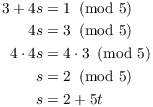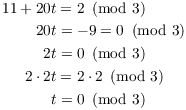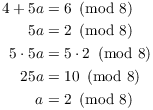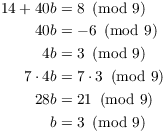The Chinese Remainder Theorem says that
certain systems of simultaneous congruences with different
moduli have solutions. The idea embodied in the theorem was
known to the Chinese mathematician Sunzi in the ![]() century A.D. --- hence the name.
century A.D. --- hence the name.
I'll begin by collecting some useful lemmas.
Lemma 1. Let m and ![]() , ...,
, ..., ![]() be positive integers.
If m is relatively prime to each of
be positive integers.
If m is relatively prime to each of ![]() , ...,
, ..., ![]() , then it is
relatively prime to their product
, then it is
relatively prime to their product ![]() .
.
Proof. If ![]() , then there is a prime p
which divides both m and
, then there is a prime p
which divides both m and ![]() . Now
. Now ![]() , so p must divide
, so p must divide ![]() for some i. But p divides both m and
for some i. But p divides both m and ![]() , so
, so ![]() . This
contradiction implies that
. This
contradiction implies that ![]() .
.![]()
For example, 6 is relatively prime to 25, to 7, and to 11. Now ![]() , and
, and ![]() .
.
I showed earlier that the greatest common divisor ![]() of a and b is greatest in the
sense that it is divisible by any common divisor of a and b. The next
result is the analogous statement for least common multiples.
of a and b is greatest in the
sense that it is divisible by any common divisor of a and b. The next
result is the analogous statement for least common multiples.
Lemma 2. Let m and ![]() , ...,
, ..., ![]() be positive integers.
If m is a multiple of each of
be positive integers.
If m is a multiple of each of ![]() , ...,
, ..., ![]() , then m is a multiple
of
, then m is a multiple
of ![]() .
.
Proof. By the Division Algorithm, there are unique numbers q and r such that
![]()
Now ![]() divides both m and
divides both m and ![]() , so
, so ![]() divides r. Since this is true for all i, r is a
common multiple of the
divides r. Since this is true for all i, r is a
common multiple of the ![]() smaller than the
least common multiple
smaller than the
least common multiple ![]() . This is only possible if
. This is only possible if ![]() . Then
. Then ![]() , i.e. m is a multiple of
, i.e. m is a multiple of
![]() .
.![]()
For instance, 88 is a multiple of 4 and 22. The least common multiple of 4 and 22 is 44, and 88 is also a multiple of 44.
Lemma 3. Let ![]() , ...,
, ..., ![]() be positive integers.
If
be positive integers.
If ![]() , ...,
, ..., ![]() are pairwise relatively prime (that is,
are pairwise relatively prime (that is, ![]() for
for ![]() ), then
), then
![]()
Proof. Induct on n. The statement is trivially
true for ![]() , so I'll start with
, so I'll start with ![]() . The statement for
. The statement for ![]() follows from the equation
follows from the equation ![]() :
:
![]()
Now assume ![]() , and assume the result is true
for n. I will prove that it holds for
, and assume the result is true
for n. I will prove that it holds for ![]() .
.
Claim: ![]() .
.
(Some people take this as an iterative definition of ![]() .)
.) ![]() is a multiple of each
of
is a multiple of each
of ![]() , ...,
, ..., ![]() , so by Lemma 2 it's a multiple of
, so by Lemma 2 it's a multiple of ![]() . It's also a multiple of
. It's also a multiple of ![]() , so
, so
![]()
On the other hand, for ![]() ,
,
![]()
Therefore,
![]()
Obviously,
![]()
Thus, ![]() is
a common multiple of all the
is
a common multiple of all the ![]() 's. Since
's. Since ![]() is the least common multiple, Lemma 2 implies that
is the least common multiple, Lemma 2 implies that
![]()
Since I have two positive numbers which divide one another, they're equal:
![]()
This proves the claim.
Returning to the proof of the induction step, I have
![]()
The second equality follows by the induction hypothesis (the
statement for n). The third equality follows from Lemma 1 and the
result for ![]() .
.![]()
As an example, 6, 25, and 7 are relatively prime (in pairs). The
least common multiple is ![]() .
.
Theorem. ( The Chinese
Remainder Theorem) Suppose ![]() , ...,
, ..., ![]() are pairwise
relatively prime (that is,
are pairwise
relatively prime (that is, ![]() for
for ![]() ). Then the following system of congruences
has a unique solution mod
). Then the following system of congruences
has a unique solution mod ![]() :
:

Notation.
![]()
For example,
![]()
This is a convenient (and standard) notation for omitting a single
variable term in a product of things.![]()
Proof. Define
![]()
That is, ![]() is the product of the m's with
is the product of the m's with
![]() omitted. By Lemma 1,
omitted. By Lemma 1, ![]() . Hence, there are numbers
. Hence, there are numbers ![]() ,
, ![]() such that
such that
![]()
In terms of congruences,
![]()
Now let
![]()
If ![]() , then
, then ![]() , so mod
, so mod ![]() all the terms but the k-th term are 0 mod
all the terms but the k-th term are 0 mod ![]() :
:
![]()
This proves that x is a solution to the system of congruences (and incidentally, gives a formula for x).
Now suppose that x and y are two solutions to the system of congruences.

Then
![]()
Thus, ![]() is a multiple of all the m's, so
is a multiple of all the m's, so
![]()
But the m's are pairwise relatively prime, so by Lemma 3,
![]()
That is, the solution to the congruences is unique mod ![]() .
.![]()
Example. Solve
![]()
![]() , so there is a unique solution
mod 36. Following the construction of x in the proof,
, so there is a unique solution
mod 36. Following the construction of x in the proof,
![]()
![]()
Solution:
![]()
Example. Solve

The moduli are pairwise relatively prime, so there is a unique solution mod 60. This time, I'll solve the system using an iterative method.
![]()
But ![]() , so
, so

Hence,
![]()
Finally, ![]() , so
, so

Hence, ![]() .
.
Now put everything back:
![]()
Example. Calvin Butterball keeps pet meerkats in his backyard. If he divides them into 5 equal groups, 4 are left over. If he divides them into 8 equal groups, 6 are left over. If he divides them into 9 equal groups, 8 are left over. What is the smallest number of meerkats that Calvin could have?
Let x be the number of meerkats. Then

From ![]() , I get
, I get ![]() . Plugging this into the second congruence,
I get
. Plugging this into the second congruence,
I get

Hence, ![]() . Plugging this into
. Plugging this into ![]() gives
gives
![]()
Plugging this into the third congruence, I get

Hence, ![]() . Plugging this into
. Plugging this into ![]() gives
gives
![]()
The smallest positive value of x is obtained by setting ![]() , which gives
, which gives ![]() .
.![]()
You can sometimes solve a system even if the moduli aren't relatively prime; the criteria are similar to those for solving system of linear Diophantine equations.\blank
Theorem. Consider the system
![]()
(a) If ![]() , there are
no solutions.
, there are
no solutions.
(b) If ![]() , there is a
unique solution mod
, there is a
unique solution mod ![]() .
.
Note that if ![]() , case (b)
automatically holds, and
, case (b)
automatically holds, and ![]() ---
i.e. I get the Chinese Remainder Theorem for
---
i.e. I get the Chinese Remainder Theorem for ![]() .
.
Proof. (a) I'll prove the contrapositive. Suppose x is a solution to the system of congruences, so
![]()
The first congruence gives ![]() , so
, so ![]() . Similarly,
. Similarly, ![]() . But
. But ![]() and
and ![]() , so
, so
![]()
Therefore,
![]()
This proves the contrapositive of the assertion, so (a) is true.
(b) First, suppose that if x and y are solutions to the system.
![]()
Thus, ![]() . Similarly,
. Similarly, ![]() . Since
. Since ![]() is a multiple of
is a multiple of ![]() and
and ![]() , it is a multiple of
, it is a multiple of
![]() . Thus,
. Thus,
![]()
Thus, any two solutions are congruent mod ![]() .
.
Now suppose ![]() , so
, so ![]() for some
for some ![]() . Note that
. Note that
![]()
It follows that ![]() is
invertible mod
is
invertible mod ![]() ,
so there is an integer p such that
,
so there is an integer p such that
![]()
I claim that the following is a solution to the system for all ![]() :
:
![]()
You can obtain this "guess" by working backwards from the system assuming there is a solution, and solving the congruences by basic algebra. I will omit the details.
First, since ![]() ,
,
![]()
This shows that the proposed solution satisfies the first congruence.
Next. I need to reduce ![]() mod
mod ![]() and show that I get
and show that I get
![]() . I'll need the following facts. First,
since
. I'll need the following facts. First,
since ![]() , we have
, we have ![]() .
.
Second, since ![]() , we have
, we have
![]()
Hence,
![]()
![]()
![]()
This shows that ![]() solves the congruences for all
solves the congruences for all ![]() --- and so
--- and so ![]() is a solution mod
is a solution mod ![]() . Our initial observation shows that this
is the only solution mod
. Our initial observation shows that this
is the only solution mod ![]() .
.![]()
Let's look at an example to show how this works. Suppose we have the system of congruences
![]()
We have ![]() ,
, ![]() ,
, ![]() , and
, and ![]() . Since
. Since ![]() , the condition for a
solution is satisfied.
, the condition for a
solution is satisfied.
First, ![]() .
.
Next,
![]()
The multiplicative inverse of 6 mod 7 is ![]() . (You can find this by trial and error, or
using the Extended Euclidean Algorithm.) A solution mod
. (You can find this by trial and error, or
using the Extended Euclidean Algorithm.) A solution mod ![]() is
is
![]()
You can check that 141 solves the original congruences.
Example. Solve
![]()
Since ![]() , there is a unique
solution mod
, there is a unique
solution mod ![]() . I'll use the
iterative method to find the solution.
. I'll use the
iterative method to find the solution.
![]()
Since ![]() ,
,
![]()
Now I use my rule for "dividing" congruences: 6 divides
both 12 and 6, and ![]() , so I can
divide through by 6:
, so I can
divide through by 6:
![]()
Multiply by 2, and convert the congruence to an equation:
![]()
Plug back in:
![]()
Copyright 2022 by Bruce Ikenaga